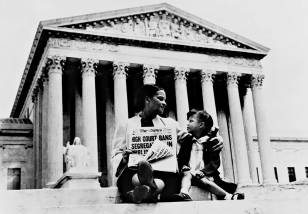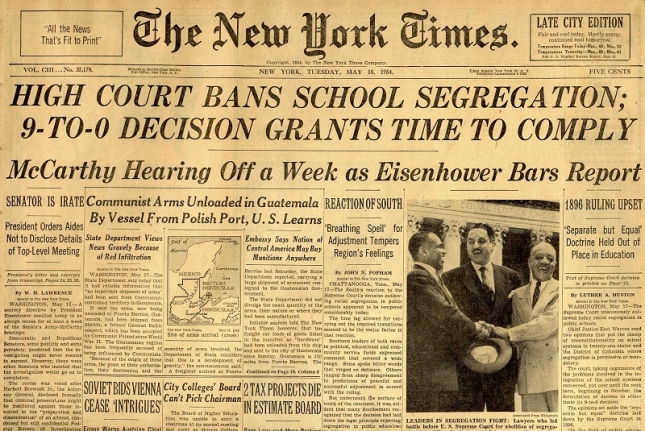

If I was to say ‘Plessy v Ferguson’ to you, you might respond with something like ‘was that a tractor race?’ Well no, actually. It’s got something to do with race all right, but not tractors. Let me just mention for the moment that the Plessy in question was a young man named Homer Plessy, an unassuming French-speaking shoemaker from Louisiana, rather than an electronics conglomerate. Ferguson was John Howard Ferguson, a New Orleans judge, and not a manufacturer of agricultural goods. Now let’s park them both for the moment.
Twenty-five years ago this week Nelson Mandela became President of South Africa. While the architects of apartheid didn’t just turn in their graves, they crawled out and demanded to be relocated. Today is also the anniversary of a pivotal, and unanimous, 1954 US Supreme Court decision in the case of Brown v. Board of Education. This ruled that racial segregation in public educational facilities was unconstitutional. The case centred on young Linda Brown an African-American girl who had been refused admission to an elementary school in Topeka, Kansas, because of her race.
Bear with me. All these events are related.
Back in 1994 Mandela and the African National Congress had finally triumphed over an iniquitous system introduced in 1948 to maintain minority white rule. Apartheid, which translates from Afrikaans as ‘separateness’ but really means ‘segregation’, was supposed to be a form of administration that allowed for the separate development of the races in South Africa. In fact, it merely institutionalised racial discrimination. Most of its supporters were fairly upfront about a regime that, for example, banned mix race marriages in 1949, and went one better the following year by forbidding sexual relations across racial lines. But there were a few of the fluffier supporters of apartheid who liked to claim that even though the races were kept apart this didn’t mean that they were not cherished equally. Picture someone watching a child being devoured by a grizzly bear going ‘nice teddy!’

But did this spurious notion of ‘separate but equal’ originate in South Africa?
This brings us back to Plessy v Ferguson. You’ll remember Homer Plessy, our Cajun shoemaker from the top of this item. Homer was something called an ‘octoroon’ – this means, in American parlance, that he was one-eighth black. In other words, one of his great grandparents was African American. In Irish terms, an octoroon is probably somebody who would be one-eighth Viking.
This meant that although he could ‘pass’—another one of those subtly coded American words—he was not legally permitted to travel in the ‘whites only’ carriage of a New Orleans rail car. So, he bought a ticket and did just that. He also arranged to be ‘discovered’ in this vile act and have himself arrested. This was done to challenge the legislation, the Louisiana Separate Car Act of 1890.
And that’s where John Howard Ferguson comes in. He was the judge who fined Homer Plessy twenty-five dollars and whose name was then attached to the case that went all the way to the Supreme Court. In 1896, in what is seen as one of the worst decisions ever by a US Supreme Court–though we have high hopes that the current bench will steal that title—Plessy was told that the penalty imposed on him did not violate the fourteenth amendment, which provides for equal treatment under the law for African Americans. Homer Plessy was, in effect, told by seven of the eight justices, that segregated facilities were perfectly all right in the USA, that he was ‘separate but equal’, and that he couldn’t have his twenty-five dollars back. To this day Plessy v Ferguson has never formally been overruled.

Which brings us back to the sixty-fifth anniversary today of the judgement in the case of Brown v Board of Education, and the desire of eleven-year-old Linda Carol Brown to go to an elementary school close to her home. The school authorities told her she couldn’t because she was black. The Supreme Court, led by Earl Warren, told the city of Topeka Kansas that she could because she was a human being. That decision, and many more like it from the liberal US Supreme Courts of the sixties and seventies, have nullified the impact of the Homer Plessy’s twenty-five dollar fine and everything that flowed from it.
So, in answer to the question did the notion of ‘separate but equal’ originate in apartheid, South Africa. No, it didn’t, the US Supreme Court got there in 1896, way ahead of Henrik Verwoerd. So, that’s fake history.

Some nice people expressing their delight at the result of Brown v Board of Education
You must be logged in to post a comment.